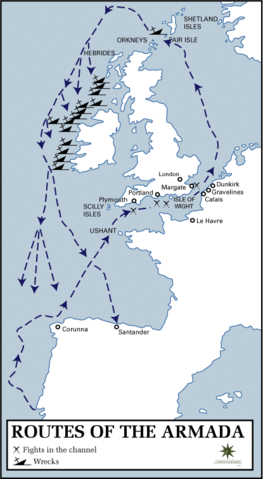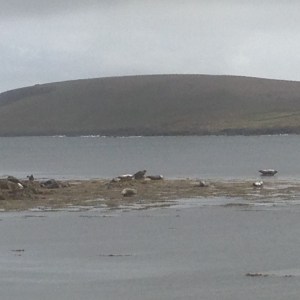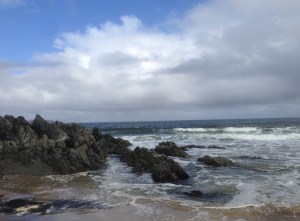 The ocean floor is a surprisingly busy place. Teeming, you might say, with lost life. The UN reckons three million shipwrecks are scattered around the bottom of the world’s seas. Small yachts and fishing smacks, Viking longboats and German U-boats… the sea now owns the lot, regardless of what governments or salvage operators might think. The Irish sea area claim to fame is that there are said to be more ocean liners and U-boats sunk off Malin (on the Inishownen peninsula, Malin Head is the most northerly point of Ireland) than anywhere else in the world; the majority of them casualties of the World Wars.
The ocean floor is a surprisingly busy place. Teeming, you might say, with lost life. The UN reckons three million shipwrecks are scattered around the bottom of the world’s seas. Small yachts and fishing smacks, Viking longboats and German U-boats… the sea now owns the lot, regardless of what governments or salvage operators might think. The Irish sea area claim to fame is that there are said to be more ocean liners and U-boats sunk off Malin (on the Inishownen peninsula, Malin Head is the most northerly point of Ireland) than anywhere else in the world; the majority of them casualties of the World Wars.
When I went to the Isles of Scilly Museum – a place founded in 1963 because of a need to house all the finds deposited on the beach by winter seastorms – I was surprised by the contents of a display of bits and bobs washed up from the 1997 wreck of the Cita: tyres, Luck of the Irish keyrings, Dunnes Stores ‘St. Bernard’ brand shoes. It must be years since Dunnes decided that the luck of the Irish had run out as far as St Bernie was concerned and put him out to pasture. I always thought a C12th French century monk best known for his persuasive way with words was an unusual choice for a shop’s own-brand merchandise. (There were a few obligatory miracles of course, such as ridding churches of flies, and curing a child’s withered arm, but Saint-wise he wasn’t one of the biggies as far as I can see. Maybe Dunnes were referring to the dog?) Anyway, back to shipwrecks. On that trip, my flight back to Exeter from St Mary was delayed and to kill some time I flicked through a copy of the Wreck of Colossus – The Find of a Lifetime, which I found lying around in the café in St. Mary’s tiny aerodrome (okay, technically it was for sale, alongside handcrafted doilies and flower-illustration postcards, but I handled it gently).
Todd Stevens went to Scilly as a Cita salvage diver originally and ended up staying. Diving alone one day, he found a previously unknown additional site of the HMS Colossos, the 74-gun warship that sank in 1798. The ship was famously jam packed with a collection of Etruscan pottery belonging to Sir William Hamilton and – less famously – full of wounded soldiers on their way home from the Battle of the Nile. With his wife Carmen, Todd Stevens continued to explore this new area. Lying face upwards on the sand she found the most incredible thing: a twice life-size carved wooden figure that was once was part of the Colossos’ stern decoration (that’s it on the right). What struck me most about Todd Stevens’ book – and I didn’t get to read it all because a) I was out of sterling and b) my flight was called – was how honest he was about the thrill of the chase in salvage diving, and the frustration of having to leave a possible site behind and return to land. He makes it sound so addictive, the belief that just there, over there, under that rock, behind that reef, a moment of history lies trapped. A giant-sized, barnacle-encrusted ‘what if’. 
But when something wonderful, such as the carving from the Colossos, is found, what happens then? So often it is conditions of the sea itself that can preserve wrecks and their booty. Removing them from these crypts sends time spinning forward. Shipwreck sites are nearly always graves as well as treasure chests. Understandably, the focus on the human cost of a shipwreck gets more prominence the more recent the disaster. Whizz back in time and the people tend to get forgotten about. We will never know who were the crew of fifteen on the 3,000 year old paddle-powered boat discovered in sea area Plymouth in 2009. Its cargo of copper and tin ingots, a bronze sword and three gold torcs are seen as evidence that there was a much more sophisticated European communications and trading system in operation than was preciously believed. Engineer Jim Tyson who took part in the dives said: ‘You have something in your hands that had not seen the light of day in 3000 years. The last person to do so must have died in the shipwreck.’ A thoughtful comment to make, considering that the temptation must be to jump up and down in delight with joy at finding a haul dating back to 900BC.
Underneath the invisible lines that create the jigsaw that is the Shipping Forecast, all the sea areas have their own shipwreck secrets and stories. One of the quirkier ones is that of the SS Politician, which was fictionalised as the SS Cabinet Minister in the in the novel Whisky Galore! by Compton MacKenzie. An 8,000-tonne cargo ship, the SS Politican left Liverpool on 3rd February 1941, heading for Jamaica and New Orleans. Two days later she ran aground of the northern coast of Eriskey in the Outer Hebrides during a gale. The crew all survived and spilled the beans about the ship’s cargo to the locals. A clue as to said cargo is in the title of the book. Yip, malt whisky. And galore. 264000 bottles of the stuff in fact. Thanks to wartime rationing the island’s own supplies of whisky were long gone, so who could blame them for deciding to help themselves before the seals got the lot? It wasn’t stealing, according to the enterprising fishermen who dressed as women so as not to be caught with telltale oil stains from the ship’s hold on their clothes. Nope, all was fine and dandy, according to the rules of salvage. Problem was, the local customs and excise officer thought otherwise: Charles McColl insisted the police take action, with the result that a number of islanders were convicted. Their sentences ranged from a £3 fine to six weeks imprisonment. The Politican proved resistant to official salvage attempts and – this being wartime, you can imagine how distracted the bods in charge were – it was decided to simply leave the stricken ship where she was. McColl estimated that 24,000 bottles had been stolen already and that simply abandoning the ship to its fate would prove too much temptation, so he got permission to explode her hull. Now that must have been some sight for the recently drunk, also recently hungover but now sadly newly sober, islanders to witness. Whisky Galore was released as an Ealing comedy in 1949. I wonder if Charles McColl ever saw the movie?
In the same month the SS Politican brought such brief, unintended happiness to the Hebrides, the SS Gairsoppa took a direct hit from a German U-boat’s torpedo. It sank in less than 20 minutes at 50 degrees N, 14 west, close to where sea areas Shannon and Sole meet. Only three of the crew managed to escape in a lifeboat. They reached Cornwall two weeks later, where two of them died trying to get ashore. Last year, 2,792 silver ingots worth €27m were recovered from the site three miles (!) below the surface. Despite this massive haul, the SS Gairsoppa is relatively small beans compared with Ireland’s other shipwreck connections. Our biggest claim to shipwreck fame is generally taken to be the Belfast-born Titanic, which sank on its maiden voyage in 1912. However, fascinating as its story of hubris is, I’ll see your Titanic and raise you the Spanish Armada.
 The route followed by the Spanish Armada – both intentionally and not – by this fleet begins in Sea Areas Trafalgar and Biscay. In fact, it covers most of our Shipping Forecast map, not that even the word ‘forecast’ would have made any sense at the time, this being centuries before Sir Robert Fitzroy.
The route followed by the Spanish Armada – both intentionally and not – by this fleet begins in Sea Areas Trafalgar and Biscay. In fact, it covers most of our Shipping Forecast map, not that even the word ‘forecast’ would have made any sense at the time, this being centuries before Sir Robert Fitzroy.
In September 1588 Philip II decided he’d take a pop at invading England, and sent a fleet of 130 ships carrying almost 30,000 men with that express purpose. It didn’t go well, this tale of old against new: the heavy galleons of the Spanish were more like floating castles than ships, versus the newer Elizabethan ‘race ships’ that were low and fast, with much lighter armoury. The beautifully named Battle of Gravelines sent his fleet, well, fleeing. As the remaining ships tried to scarper, a combination of bad weather and poor navigation drove them towards the west coast of Ireland. Queen Elizabeth was concerned about a possible Irish/Spanish alliance against her and so her man on the ground Sir Richard Bingham (a tough cookie, as pirate queen Granuaile was soon to discover, and you can read about here) and the Lord Deputy William Fitzwilliam issued orders: “to make inquiry by all good means, both by oath and otherwise, to take all the hulls of ships, stores, treasures, etc. into your hands and to apprehend and execute all Spaniards found there of what quality so ever. Torture may be used in prosecuting this inquiry.” Ouch. 24 Spanish ships were wrecked off the Irish coastline, and it is estimated that 5,000 men died. In the centuries since, 10,000 pieces of treasure, from forks to cannonballs and rubies to coins, that once journeyed through what we know as Trafalgar and Biscay, have washed up on Irish shores.
And finally: to Bailey. Not the sea area this time, but a person. Two in fact. Maurice and Maralyn Bailey decided to move to New Zealand and so in June 1972 they set sail from Southampton on their 31-foot yacht, the Auralyn. Everything was going fine and dandy until, off the coast of Guatemala, a whale got up close and personal, with the result that – well, you can imagine the result. They roped their dingy and life-raft together and grabbed what supplies they could. From the dingy they watched their yacht disappear. In a diary entry dated March 4 1973 (but written after the event), non-swimmer Maralyn Bailey wrote of “a violent impact. The ship shuddered and there was tearing, splintering wood. We looked at each other. I dashed outside. As I went into the cockpit, I saw, off the stern, a huge whale. Around him the deep blue water was stained red“. If they had been told on that morning that they would still be on that small raft 117 days later, I wonder would they have stayed put or jumped in after the Auralyn? When their supplies ran out they survived on rainwater and by catching turtles, birds and even small sharks with their bare hands and a safety pin. Seven times other boats were nearby and failed to spot them as they drifted in the Pacific becoming increasingly malnourished and weak. 1,500 miles later the Baileys were spotted by a Korean fishing boat, the Weolmi 306. They had each lost 40 pounds in weight and could barely stand. The water had rotted their clothes and their bodies were covered in sores. In their 1974 book 117 Days Adrift (published as Staying Alive! in the US; please note the jaunty exclamation mark.) they wrote that to keep their spirits up they played dominoes and cards made out of pages ripped from a notebook; and drew up elaborate plans for celebratory feasts.
A year later the Baileys were back at sea in the Auralyn II.
—–
I came across this plaque dedicated to the crew of the SS Hop in a graveyard on Unst in the Shetlands in sea area Fair Isle. You can read about that trip here.
Oh, and if you think the Titanic was spectacularly ill-fated, then spare a thought for the Vasa, a Swedish warship that too sank on its maiden voyage. To be fair to the Titanic, she did get a fair bit into the journey before that iceberg got in the way. In 1628, the Vasa managed only to get 1,300 metres away from dock before foundering. In the 1950s the Swedes dug the ship out of what had become a busy shipping lane on the outskirts of Stockholm’s harbour. The custom-built Vasa Museum is a hugely popular tourist attraction, and the ship has become a symbol of what is known as Sweden’s ‘great power period’. (Not, you note, of a great shipbuilding period.)
—-
The General Synopsis At Midnight is my exploration of the sea areas of the BBC R4 Shipping Forecast, thanks to the Maeve Binchy Travel Award. The earlier post ‘Counting Down To Midnight’ explains the project. A piece based on the project called ‘The Shipping Forecast’ broadcast on Sunday Miscellany, RTE Radio 1, November 2nd.
Want to sea more?
Warships, U-Boats and Liners: A guide to shipwrecks mapped in Irish waters by Charise McKeon, Karl Brady, James Lyttleton and Ian Lawler. Published by The Stationery Office, Dublin (2012).
117 Days Adrift by Maurice and Maralyn Bailey published by A&C Black.
There are plenty of Irish resources about the Spanish Armada, such as http://www.sligoheritage.com/ArchSpanishArmada.htm and http://www.clarelibrary.ie/eolas/coclare/history/spanish_armada.htm
And thank’ee Wikipedia for the Spanish Armada map.















